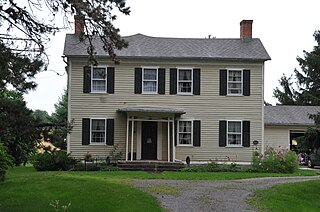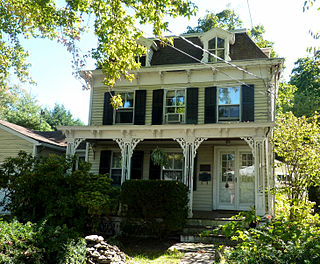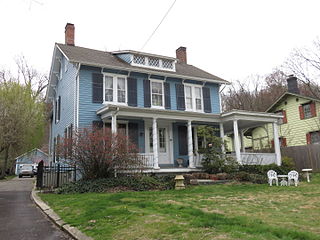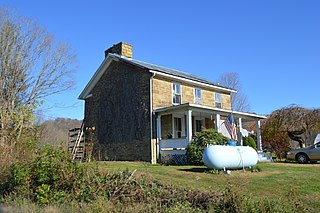
This is intended to be a complete list of properties and districts listed on the National Register of Historic Places in Orleans County, New York. The locations of National Register properties and districts may be seen in a map by clicking on "Map of all coordinates". Two listings, the New York State Barge Canal and the Cobblestone Historic District, are further designated a National Historic Landmark.

Deke House, the Delta Kappa Epsilon or "Deke" House on the campus of Cornell University, was built in 1893 and was listed on the National Register of Historic Places in 1991. It was designed by William Henry Miller to serve as a fraternity house. Two trees which Theodore Roosevelt planted in front of the house are on the National Register of Historic Trees.

There are 75 properties listed on the National Register of Historic Places in Albany, New York, United States. Six are additionally designated as National Historic Landmarks (NHLs), the most of any city in the state after New York City. Another 14 are historic districts, for which 20 of the listings are also contributing properties. Two properties, both buildings, that had been listed in the past but have since been demolished have been delisted; one building that is also no longer extant remains listed.

St. Stephen's Episcopal Church is a historic Episcopal church located at Olean in Cattaraugus County, New York. It is a Gothic Revival style church building designed by upstate New York architect Robert W. Gibson (1854–1927) and constructed 1889–1890. The complex also includes the Ashton Parish House, constructed 1922–1923, and the rectory, known as the Watson Wing, built about 1885. It is home to Olean's oldest continuously operating congregation, established in 1830.

Ward House, also known as the William Allen House, is a historic home located at Westfield in Chautauqua County, New York. It is a 2-story, L-shaped brick Italian Villa–style residence built in the late 1860s. The home features a prominent cupola, and the property has a 1+1⁄2-story frame barn.

Dayton House is a historic home located at Lima in Livingston County, New York. It was built about 1844 and expanded and upgraded in the 1850s / 1860s. It is a two-story, three bay dwelling with Greek Revival form and an overlay of Italianate and Gothic Revival design elements. Also on the property is a large carriage house, smoke house, and original cast iron lamp post.

Thomas Peck Farmhouse is a historic home located at Lima in Livingston County, New York. It was built about 1812 and remodeled sometime between the 1860s and 1880s. It is a two-story, five bay Federal style stone building with late 19th century Italianate and Gothic Revival inspired design features. The house is built of fieldstone and faced in cut limestone. Also on the property are three contributing dependencies and one contributing site: a privy, an ice house, a guest / tenant house, and the remains of a former barn complex.

William Shirts House, also known as Camperdown Farm, is a historic home in Scottsville in Monroe County, New York. The vernacular Federal-style house was built about 1825. It is composed of a 2-story, four-by-two-bay, main block with a 2-story rear wing.

William C. Jayne House is a historic home located at Webster in Monroe County, New York. The principal building is a large 2+1⁄2-story house that combines simple Queen Anne style massing and Colonial Revival style decorative features. It was built in 1917–1918, and incorporates high quality construction materials including narrow Roman brick, cast stone, stucco and wood detailing, and ceramic roof tiles.

Farrand-Pierson House is a historic home located at Newark Valley in Tioga County, New York. The house is a "T" shaped structure. The main section of the house was built about 1860 in the Greek Revival style, while the rear wing appears to incorporate an earlier house dating to about 1830. Also on the property are a small barn, hog house, and chicken house.

Charles M. Weeks House is a historic home located at Huntington in Suffolk County, New York. It is a 2+1⁄2-story, clapboard residence with a mansard roof. It was built about 1860 and representative of the Second Empire style. It has a 2-story shed-roofed kitchen wing. Also on the property is a barn built about 1900.

Dederer Stone House-Stonehurst is a historic home located at Orangetown in Rockland County, New York. It was built in 1865 and is a 2+1⁄2-story, "T" shaped dwelling constructed using regular size units of local granite with dressed sandstone trim. It features a jerkinhead roof. Also on the property is a 2-story barn and stone hitching post.

Sunnyslope is a historic home located in Hunts Point in the South Bronx in New York City. It was built about 1860 by Peter Hoe, brother of Richard March Hoe, on their family estate. It is a 2+1⁄2-story Gothic Revival–style house built in the Picturesque mode. In 1919 it was sold to Temple Beth Elohim and later became home to an African Methodist Episcopal congregation.
Dick House is a historic home located at Germantown in Columbia County, New York. It was built about 1860 and is five bays wide and two bays deep with a gable roof. There is a flat roofed west wing. It has a center hall plan with Italianate style detailing on the interior.
Henry-Remsen House was a historic home located at Colonie in Albany County, New York. It was an example of a Greek Revival–style farmhouse. The earliest portion of the house, a 1+1⁄2-story ell, was built between about 1830 and 1850. The main structure was two stories with a pedimented gable roof. Other additions were completed between 1860 and the 1920s. Also on the property was a contributing barn. It is no longer extant; it has been dismantled.

Stephen and Charles Smith House is a historic home located at Roslyn Harbor in Nassau County, New York. It was built about 1860 and is a 2+1⁄2-story timber frame dwelling with a 2+1⁄2-story ell in a vernacular Italianate style. It features a full-width porch on the front elevation. From 1892 to 1914, it was the property of Nora Godwin, granddaughter of William Cullen Bryant.

A.D. (Boss) Jones House is a historic home located at Duanesburg in Schenectady County, New York. It was built about 1860 by noted master carpenter Alexander Delos "Boss" Jones. It is a two-story, five bay frame farmhouse in a late-Greek Revival style with Italianate features. It features innovative stacked plank construction, a hipped roof, a wide frieze, and broad corner pilasters. Also on the property are two contributing barns and a shed.

William Wells House, also known as the "Stone House" or "Stonehurst," is a historic home located at Tyler City, Tyler County, West Virginia. It was built about 1801–1804, and is a modest 2-story sandstone residence. The house is nearly square and has an unusually large interior chimney. A Victorian-style frame addition was built about 1895 at the rear of the house. It is recognized as the county's oldest house. Also located on the property is the family burial ground where Wells' grave marker stands.
Martin–Fitch House and Asa Fitch Jr. Laboratory, also known as the Fitch House, is a historic home and laboratory located at Salem, Washington County, New York. The house was built about 1787, and modified between about 1796 and 1812, and again about 1830. It is a two-story, five bay, Late Georgian style heavy timber frame dwelling. It has a steep hipped slate roof with dormers and two interior chimneys. The Asa Fitch, Jr. Laboratory, or “Bug House,” was built about 1825 and enlarged about 1860. It is a small two-story, gable roofed frame rectangular building with a lean-to addition. Also on the property are the contributing barn and milk house. It was the home and laboratory of Asa Fitch (1809-1879), first occupational entomologist in the U.S.

One Pendleton Place, also known as the William S. Pendleton House, is a historic home located in the New Brighton neighborhood of Staten Island, New York. It was built in 1860, and is a three-story, picturesque Italianate villa style frame dwelling with a multi-gabled roof. It features asymmetrical massing, a four-story conical-roofed entry tower, and multiple porches including a wrap-around verandah.




















